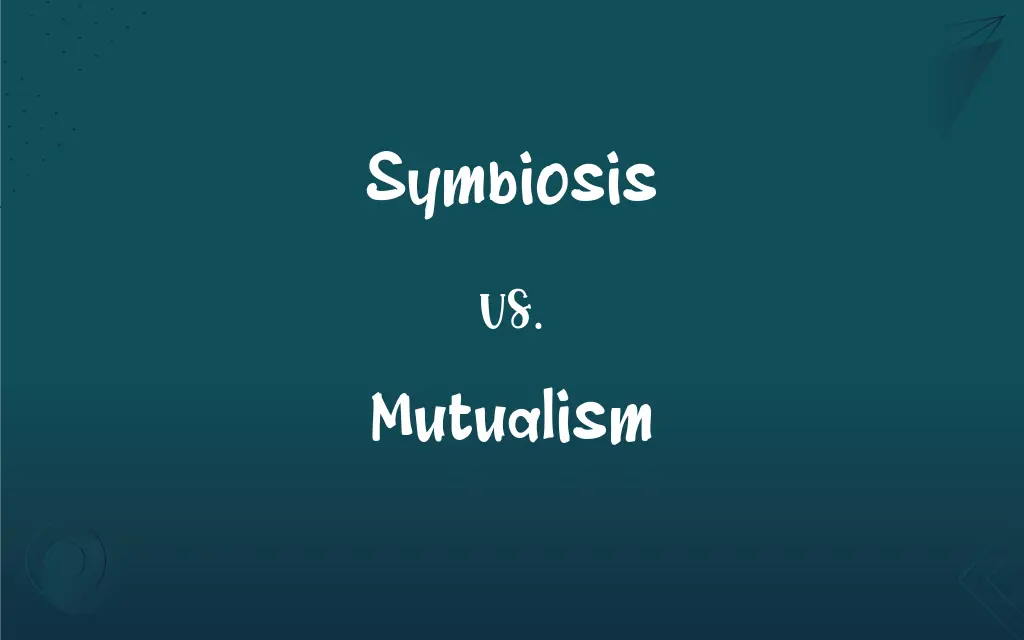Symbiosis vs. Mutualism: What's the Difference?
Edited by Janet White || By Harlon Moss || Published on January 9, 2024
Symbiosis refers to any close and long-term biological interaction between two different organisms, while mutualism is a type of symbiosis where both parties benefit.

Key Differences
Symbiosis encompasses various types of close biological interactions between two different species, including mutualism, commensalism, and parasitism. Mutualism, a subset of symbiosis, specifically describes interactions where both species benefit from the relationship.
In symbiosis, the relationship can range from beneficial to harmful for the involved organisms, depending on the type. In mutualism, however, the relationship is always mutually beneficial, providing advantages to both participants.
Examples of symbiosis include the complex relationships in ecosystems, such as predator-prey dynamics, parasitic infections, or commensalism. Mutualism examples are more specific, like the relationship between bees and flowering plants, where both parties gain.
The nature of symbiosis can change over time and can vary in dependency level. Mutualism generally remains constant in its beneficial nature and often involves a high level of interdependence between the species.
Symbiosis can occur in various forms and intensities, from loose associations to life-long dependencies. Mutualism often involves co-evolved relationships where the survival of one or both parties is significantly enhanced by the other.
ADVERTISEMENT
Comparison Chart
Definition
Long-term interaction between two different species
A symbiotic relationship where both parties benefit
Types
Includes mutualism, commensalism, and parasitism
A specific type of symbiosis
Benefit Distribution
Varies, can be one-sided or mutual
Always mutual
Examples
Predator-prey, host-parasite, algae and fungi
Pollinators and flowers, clownfish and anemones
Dependency Level
Can range from low to high
Often involves high interdependence
ADVERTISEMENT
Symbiosis and Mutualism Definitions
Symbiosis
The relationship in symbiosis can be physical or behavioral.
Birds nesting in trees is an example of behavioral symbiosis.
Mutualism
It often involves co-evolution of the involved species.
The mutualism between certain fish and cleaning shrimp has evolved over millions of years.
Symbiosis
Symbiosis is a close, long-term association between two different species.
The symbiosis between coral and algae is crucial for coral reef ecosystems.
Mutualism
Mutualism enhances the survival chances of both parties.
In mutualism, like that between certain plants and nitrogen-fixing bacteria, both organisms thrive.
Symbiosis
Symbiosis is essential for the balance of many ecosystems.
In the forest, symbiosis between fungi and tree roots enhances nutrient absorption.
Mutualism
Mutualism is a symbiotic relationship where both species benefit.
The mutualism between bees and flowers is vital for pollination and food production.
Symbiosis
It can include various types of relationships, like mutualism or parasitism.
Symbiosis in nature is diverse, ranging from beneficial to harmful interactions.
Mutualism
It can be obligatory, where both species are dependent on each other.
The mutualism between some ants and aphids is so obligatory that they are rarely found apart.
Symbiosis
Symbiosis can involve varying degrees of dependency.
Some symbiotic relationships are so close that the species cannot survive independently.
Mutualism
Mutualism contributes significantly to biodiversity.
Mutualism helps maintain biodiversity by promoting interdependent relationships.
Symbiosis
(Biology) A close, prolonged association between two or more different organisms of different species that may, but does not necessarily, benefit each member.
Mutualism
An association between two organisms of different species in which each member benefits.
Symbiosis
A relationship of mutual benefit or dependence.
Mutualism
(ecology) Any interaction between two species that benefits both; typically involves the exchange of substances or services.
Mutualism
An economic theory and anarchist school of thought that advocates a society where each person might possess a means of production, either individually or collectively, with trade representing equivalent amounts of labor in the free market.
Mutualism
The doctrine of mutual dependence as the condition of individual and social welfare.
Mutualism
The relation between two different species of organisms that are interdependent; each gains benefits from the other
FAQs
What is symbiosis?
A long-term interaction between two different species.
Is mutualism always beneficial?
Yes, both species benefit in mutualism.
What is mutualism?
A type of symbiosis where both parties benefit.
Can symbiosis be harmful?
Yes, in cases like parasitism.
Do symbiotic relationships evolve?
Yes, they can evolve over time.
Can symbiosis be temporary?
Some symbiotic relationships are temporary, while others are lifelong.
Is symbiosis common in nature?
Very common across various ecosystems.
How does mutualism affect ecosystems?
It often enhances biodiversity and ecosystem stability.
What's an example of symbiosis in the ocean?
The relationship between clownfish and sea anemones.
Are mutualistic relationships always necessary for survival?
In some cases, yes, especially in obligatory mutualism.
Can mutualism occur between plants and animals?
Yes, like pollinators and flowering plants.
How does mutualism contribute to evolution?
It can drive co-evolution and adaptation in species.
Are symbiotic relationships always between two species?
Typically, though complex interactions can involve more.
Can mutualistic relationships become parasitic?
It's rare, but changes in environmental conditions can shift the nature of the relationship.
Can symbiotic relationships change over time?
Yes, they can evolve or shift in nature.
How do scientists study symbiosis?
Through ecological, genetic, and behavioral research.
Does mutualism require close physical contact?
Often, but not always; it can also be behavioral.
What roles do species play in mutualism?
They provide benefits like protection, nutrients, or pollination to each other.
What's a human-related example of symbiosis?
The gut microbiome in humans is a form of symbiosis.
What's a famous example of mutualism in agriculture?
Nitrogen-fixing bacteria and legume plants, enhancing soil fertility.
About Author
Written by
Harlon MossHarlon is a seasoned quality moderator and accomplished content writer for Difference Wiki. An alumnus of the prestigious University of California, he earned his degree in Computer Science. Leveraging his academic background, Harlon brings a meticulous and informed perspective to his work, ensuring content accuracy and excellence.
Edited by
Janet WhiteJanet White has been an esteemed writer and blogger for Difference Wiki. Holding a Master's degree in Science and Medical Journalism from the prestigious Boston University, she has consistently demonstrated her expertise and passion for her field. When she's not immersed in her work, Janet relishes her time exercising, delving into a good book, and cherishing moments with friends and family.






































































